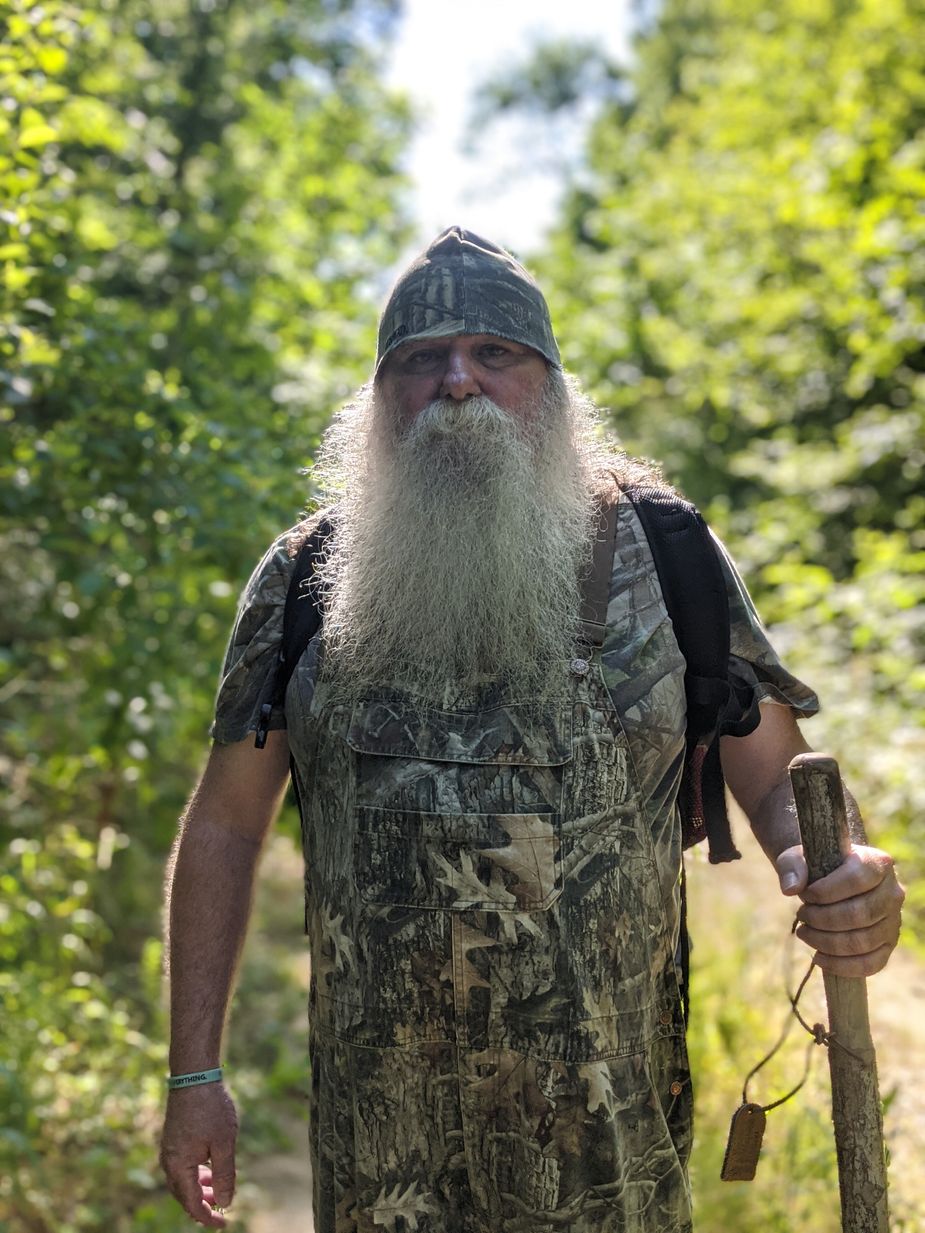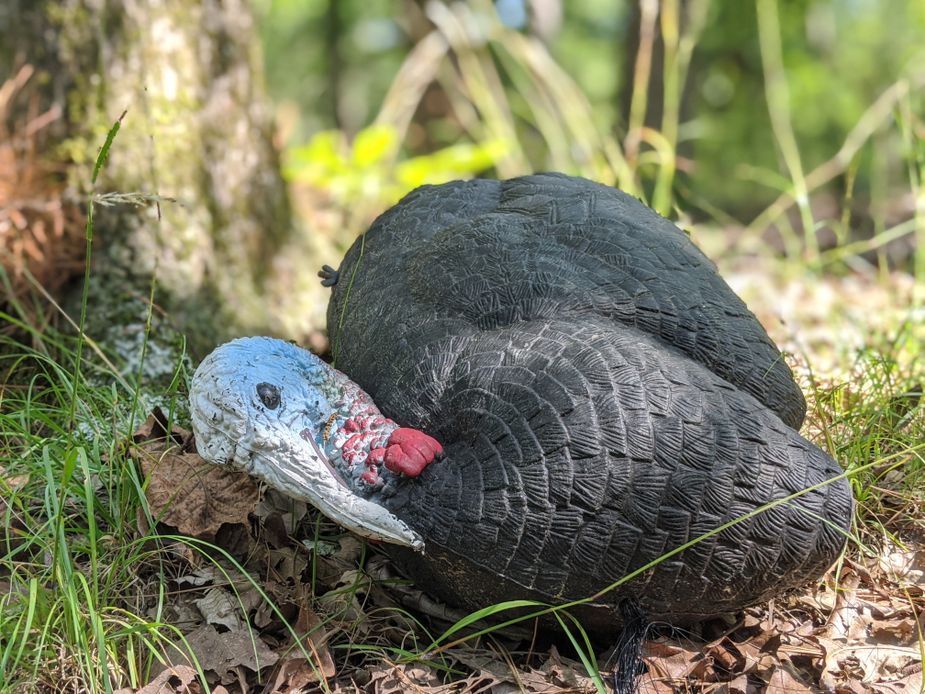Something in the Woods
Published February 2024
By Greg Elwell | 17 min read
Rumors of Oklahoma’s flat, featureless terrain have been greatly exaggerated, especially considering the landscape of the state’s southeastern quadrant. There are mountains, trees, and plenty of areas inhospitable to development—the perfect place for the unknown to remain unknown.
Bigfoot lore is big business in southeastern Oklahoma. Every little gift shop—including the one at Beavers Bend State Park—has T-shirts, coffee mugs, and other various bric-a-brac bearing the creature’s iconic silhouette. If a logo proclaiming the hairy cryptid the “World Hide-and-Seek Champion” tickles your funny bone, there are plenty of products from which to choose. Cartoon versions grace business signs at Rugaru Adventures ziplining and BigFoot Speedway Go-Karts in Hochatown.
But for some in southeastern Oklahoma, Bigfoot is neither a mascot nor a joke: It’s a neighbor.

The Ouachita National Forest covers 1.8 million acres of southeastern Oklahoma and Arkansas. Those who search its mountainous reaches for signs of Bigfoot say the storied cryptid hides somewhere in these remote hills. Photo by Kim Baker/Oklahoma Tourism
In a roundabout way, Bigfoot was the tom turkey’s greatest revenge on Charles Benton.
Clad in camouflage, his long gray beard in front and curly salt-and-pepper hair hanging down his back, the Hochatown resident cuts an imposing figure. Out on Three Bridges Road, an aptly named gravel path that winds through the undeveloped backwoods around Hochatown—past the wild blackberry bushes, beyond the tree that fell across the path, and into the dense thicket of green—Benton reckoned it was his four-year obsession with one specific tom that made him a believer. He was an avid turkey hunter, especially in the days when the season lasted a full month, and he had a target: an old tom with a harem of hens that served as a warning system.
“You don’t get to be as big and old as that bird by being stupid,” Benton says. “I hunted that tom every season for years, but I never got him.”
Up early, out late, hidden in a blind or buried in the ground alone—or even with a fellow hunter he calls the Turkey Slayer—Benton never could get that wily old bird. That’s why he was up on Devil’s Backbone that day. That’s why he heard those sounds.
“I always wanted to believe in Bigfoot,” he says.

Charles Benton is among the many southeastern Oklahoma residents who have had strange encounters with the hairy enigma during their outdoor expeditions. Photo by Greg Elwell
It seemed like fun to think this mythical creature was hidden just a few miles away through southeastern Oklahoma’s dense brush, living its best life parallel to his own. Maybe that’s why Benton went to investigate when he heard that noise like a cross between a heron’s call and a groan. And if he was hearing it, certainly any prey he was hoping to shoot—including the turkey that had eluded him those three seasons—was hearing it, too.
“So I decided to go see if I could figure out what it was,” he says.
It’s not hard to believe the state’s southeastern corner could hide a previously undiscovered creature. There are mountains, valleys, and twisty-turny roads that could invert anyone’s sense of direction and tie it up in a knot. Devil’s Backbone is what locals call the hills that scallop the area, rising and falling like vertebrae, and Benton was atop one of them when he heard it.
“I wasn’t watching where I was stepping. I was trying to see what was making that sound,” he says.
The ground doesn’t take kindly to being ignored, and it grabbed Benton, sending him tumbling into the earth’s embrace. When he got to his knees, he saw something standing in the creek. Faced away and bent over at first, it rose and turned toward him. It was getting close to dusk, so some of the finer details were lost, but it was big and dark brown, and it stared at him with a flat face, standing nearly eight feet tall. The water clung to its long, coarse fur.
It didn’t matter that Benton was armed. The twelve-gauge rifle in his hand, the nine-millimeter on his hip—he never even considered using them. Instead, after a stare that lasted seconds and felt eternal, he scrambled back up the hill—leaving his turkey decoy and his hunting blind behind—ran back to his Jeep, and didn’t look back.
“Consider yourself lucky,” Benton says as we stand amid the detritus of his decade-old encounter. “You’re the last person I’m bringing out here.”

Benton left this decoy turkey behind after he fled from the creature he saw in the McCurtain County forest. Photo by Greg Elwell
It’s easy to dismiss the legends when you live in the city, where darkness never really falls to the color of pitch. But even the largest cities end. The light pollution remains, at least a little, but the brush gets thicker, and the trees grow closer together. Edge farther away from home, and you’ll notice pools of darkness that seem capable of hiding anything.
Growing up in Honobia, Troy Hudson often heard stories from his friends who lived a little deeper out in the country about what they called those people.
“‘Don’t go across that river,’ they’d tell me. ‘Those people live there,’” he says. “It wasn’t until years later that I understood that they were talking about Bigfoot.”
Hudson comes from a law enforcement family. His father was a highway patrolman, and he worked for years as a police officer and a training coordinator with the U.S. Department of Veterans Affairs. It was when he was working in Dallas that someone mentioned his hometown’s conference on Bigfoot. He attended, and it reignited his interest in the creatures.
Eventually, he founded the Native Oklahoma Bigfoot Research Organization. Using his training, he teaches people how to investigate Bigfoot sightings and provides support to those who’ve had an encounter.

Those interested in investigating Bigfoot can attend weekend training sessions hosted by the Native Oklahoma Bigfoot Research Organization that teach interview, surveillance, and evidence-collection methods. Photo by Troy Hudson
“In one situation, there was a gentleman who lived outside of Antlers with his family,” Hudson says. “He told us he noticed his horses were acting funny, so he put up cameras to see what was going on. He started seeing shadows he couldn’t explain.”
Bigfoot isn’t a job for the police, he says. The Antlers homeowner was frantic and worried, because he was dealing with something that defied understanding. Hudson knew it was a delicate situation, so he approached it like a professional.
“You ask what’s happening, let them talk, and make a few notes,” he says. “You don’t want to be overbearing in your investigation. Let them be comfortable. Not knowing what’s going on can be very scary.”
NOBRO is interested in proof of the existence of Bigfoot, but they’re not trying to hunt or capture the creature. If anything, Hudson wants people to learn to live in harmony with it.
“Bigfoot has been here a lot longer than we have,” he says. “If you build a house in what used to be their pathway, they’re going to be curious. You can either learn to live with it and maybe take a few recommendations to help make your situation more comfortable, or you’ll be living in fear the rest of your life.”
Hudson says mounting lights that point away from the house can discourage them. Cutting back on foliage and shrubbery near the house—also good for fire protection—can dissuade them.
“I’ve only had one instance, down by Bonham, Texas, where the guy got up and moved, because he just couldn’t deal with it,” he says.

Whether he’s real or not, the figure of Bigfoot looms large in the folklore and tourism of southeastern Oklahoma. Illustration by Jerry Bennett
The Legend of Boggy Creek hooked a young Lyle Blackburn on the world of cryptids.
The 1972 film, shot documentary-style like a proto-Blair Witch Project, is all about a Bigfoot-like creature living near the town of Fouke, Arkansas. For Blackburn—who went on to author The Beast of Boggy Creek, Beyond Boggy Creek, and Sinister Swamps: Monsters and Mysteries from the Mire—it was the start of a lifelong interest in unexplained phenomena.
“My end goal isn’t proving the existence of cryptids; it’s about presenting the whole case and story for people to make up their own minds,” he says. “The story of people in modern times saying they saw some incredible or improbable creature is fascinating in itself. In my books especially, because I specialize in Southern cryptids, I’m always interested in pockets of the South that have different names for creatures and different tales.”
While a great deal of his work centers on Bigfoot tales and legends near Fouke, Blackburn has traveled extensively in Oklahoma researching sightings and stories. He also travels across the country to festivals and conferences about the creature.
“Economically, The Legend of Boggy Creek made a huge impact. Thousands of people came to this small area of Arkansas to hunt the creature or catch a glimpse of it. You’re seeing that same thing now in Oklahoma,” he says. “Go through the Kiamichi Mountains area, and everywhere you go, there are Bigfoot cutouts, books, and T-shirts.”
People come to an interest in Bigfoot in different ways. Many are like him, Blackburn says, and have picked up on something they loved as a child—the idea of a mythic creature that lives just beyond most human perception. Modern media has only made it easier to say, “I believe,” or even just, “I want to believe.”
Over the last decade, Blackburn has sketched out a mental map of the creature’s habitat. In Oklahoma, that’s largely along the state’s eastern and southern borders.
“Most of the sightings are in the eastern portion of the state with a lot of concentration in the southeast. Areas like the Ouachita Mountains have a long history of sightings, and the Kiamichis are part of that,” he says. “It makes sense because of the terrain. There are plenty of mountainous, rugged, and remote acres upon acres where something could survive without being seen. If someone wants to find a Bigfoot, southeastern Oklahoma is considered a hotspot, because we have so many sightings.”
Densely forested areas, especially near rivers or lakes and mountainous regions, are prime for encounters, Blackburn says. LeFlore, McCurtain, Choctaw, and Atoka counties and along the Canadian and Red rivers—all are areas where he’s found stories from people who saw something they couldn’t explain.
“People know they had an experience. They want someone to talk to who won’t be judgmental. One reason they talk to me is people know I approach it seriously,” he says. “They want to know they’re not crazy. They want answers and reassurances, almost like counseling. You can tell they aren’t making it up, because it’s affecting them emotionally and physically.”
The mystique of the unknown continues to draw people by the thousands to the Honobia Bigfoot Festival and Conference, which was scheduled for October 2 and 3 at the Kiamichi Mountains Christian Mission until it was cancelled due to COVID-19. When it returns in 2021, the festival will feature music, food, and shopping, but the main draw will be a chance to meet people who have had an encounter with a creature they believe to be Bigfoot.
Out on Devil’s Backbone, where one hill starts to look like the next, and cell service is as thin as the trees are thick, it’s easy to feel isolated and lost. Clambering through that foreboding terrain, the humidity clinging to your lungs, the idea of seeing Bigfoot is thrilling and terrifying all in the same breath. Would you scream? Would you run? Would you stand frozen in fear? Who would you tell if you saw something in the woods?
[EDITOR'S NOTE: This story was originally published in Oklahoma Today's 2020 September/October issue.]
Several shops in the Hochatown area carry Bigfoot merchandise, including:







